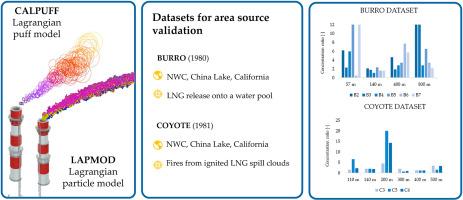Area source emissions: a validation study of CALPUFF and LAPMOD models
IF 3.4
Q2 ENVIRONMENTAL SCIENCES
引用次数: 0
Abstract
Dispersion models are essential for predicting pollutant behavior in the atmosphere, but discrepancies between models can introduce uncertainties. Validating models with real data is crucial to ensuring accuracy. Previous studies have highlighted differences between CALPUFF and the particle model LAPMOD: while both yield relatively similar results for point sources, significant discrepancies arise for area sources. This study assesses the performance of both models using experimental datasets. The analysis shows that CALPUFF estimates higher concentrations than LAPMOD and performs better against observed values, meeting all validation criteria. LAPMOD is less consistent, with a non-optimal FAC2 and high VG due to outliers caused by receptor arrangement. However, both models align well with experimental data under ideal conditions. In conclusion, CALPUFF proves more reliable, whereas LAPMOD, despite its tendency to underestimate, provides useful results once outliers are excluded.

区域源排放:CALPUFF和LAPMOD模型的验证研究
色散模型对于预测大气中污染物的行为至关重要,但模型之间的差异会带来不确定性。用真实数据验证模型对于确保准确性至关重要。先前的研究强调了CALPUFF和粒子模型LAPMOD之间的差异:虽然两者对点源产生相对相似的结果,但对面积源产生显著差异。本研究使用实验数据集评估了这两种模型的性能。分析表明,CALPUFF估计的浓度高于LAPMOD,并且对观测值的性能更好,符合所有验证标准。LAPMOD不太一致,由于受体排列引起的异常值导致FAC2非最佳,VG高。然而,在理想条件下,这两种模型都与实验数据很好地吻合。总之,CALPUFF证明更可靠,而LAPMOD,尽管其倾向于低估,一旦排除异常值,提供有用的结果。
本文章由计算机程序翻译,如有差异,请以英文原文为准。
求助全文
约1分钟内获得全文
求助全文
来源期刊

Atmospheric Environment: X
Environmental Science-Environmental Science (all)
CiteScore
8.00
自引率
0.00%
发文量
47
审稿时长
12 weeks
 求助内容:
求助内容: 应助结果提醒方式:
应助结果提醒方式:


